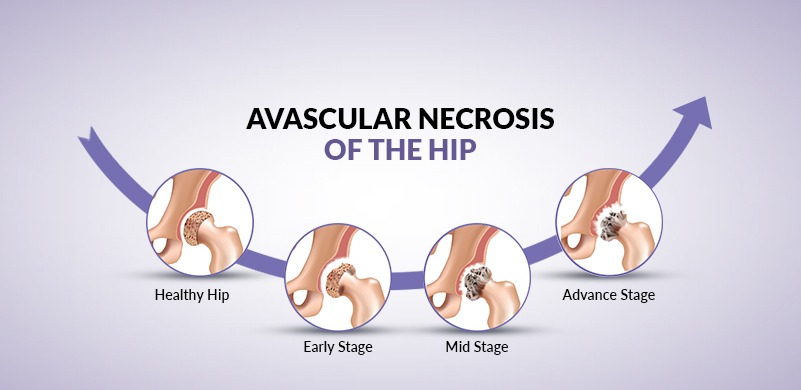What is Avascular necrosis?
Avascular necrosis (AVN) or osteonecrosis, or bone death, is a disorder that occurs due to deprived blood supply to hip joints. The hip joint is like a ball and socket joint, which is damaged due to interrupted blood supply. When AVN occurs in the hip joint, the femoral head (the ball portion) starts to go out of shape by flattening due to weight. The head which fits into a socket in an otherwise healthy state, now no longer fits perfectly due to tiny breaks in the bone. This can further lead the bone to collapse causing osteoarthritis of the hip joint.
Symptoms
- Pain in the groin, back, and down the thigh.
- Limping
- Stiffness in the hip joint
Causes
- Injury to the hip
- Fractures of the femoral neck.
- Dislocation of the femoral head out of the socket
- Corticosteroid medications, such as prednisolone or methylprednisolone.
- Smoking and alcohol abuse
- Working conditions of high atmospheric pressure, such as those of miners.
Diagnosis
- Physical examination
- X-ray
- Bone-scan
- Magnetic Resonance Imaging (MRI)
Treatment
Treatment is advised based on age, activity level, general health, and life expectancy. Pain medications relieve pain but can’t restore blood supply to the femoral head and correct the AVN. Treatment may be –
- Non-surgical – by support systems such as a walker or crutches to protect the hip from further damage by avoiding the impact of weight while moving.
Surgical – If the femoral head has not begun to collapse, surgery is done to increase the blood supply to the femoral head. Some of the surgical procedures involved are –
- Decompressing the Femoral Head – The simplest operation is to drill one or several holes through the femoral neck and into the femoral head, trying to reach the area that lacks blood supply. The procedure creates a channel for new blood vessels to quickly form in the area that lacks blood supply and relieves some of the pressure inside the bone of the femoral head. Relieving this pressure seems to help decrease the pain patients experience from AVN.
- Decompression is accompanied by using bone grafts (donor bone from the pelvic bone or lower leg) to stimulate bone growth at the site of the defect.
- The decompression operation (with or without bone grafting) is done through a small incision in the side of the thigh. An outpatient procedure in which the surgeon uses a fluoroscope to guide the drill to the affected site. Once this operation is done, you can go home with crutches the same day.
- Fibular Bone Graft – A more complicated in-patient procedure that is a tissue transplant (graft), taken from the fibula (the thin bone that runs next to the shin bone). The graft has a blood supply of its own. The surgeon
- removes a piece of the small bone (with blood vessels) in your lower leg (the fibula).
- drills a hole through the side of the femur and into the femoral head.
- connects the blood vessels of the fibula and those of the hip.
- Creates blood flow to the hips through the bone graft.
- Bone cell therapy - Bone Cell Therapy consists of using the patients' own cells (autologous) as a therapeutic tool to cure AVN. It is a natural and permanent treatment of AVN that ceases the disease progression & restores mobility.
- Rotational osteotomy and artificial hip replacement are successful procedures.
Conclusion
You might have to work with a physiotherapist to help you recover during rehabilitation. Support structures such as crutches for about six weeks post simple drilling procedure, whereas care must be taken about weight on the hip for about six months post-surgery. A recommended physical therapy regimen by your physiotherapist helps in faster recovery and fewer complications, post-joint replacement procedures.
